| 1 | Usambara green snake |
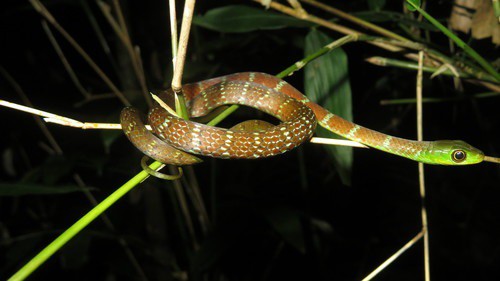
Of the 54 African countries, Tanzania hosts a particularly large amount of rare species relative to its size, and snakes are no exception. The reason is the Usambara mountain range, which was formed 2 million years ago. It peaks at just 2289 metres, but was originally coated with misty rainforest, and today is a global bodiversity hotspot. The range is divided into the east Usambara mountains in northeast Tanzania, which are wetter but lower in elevation, and the west Usambara.
One species that lives here is the Usambara green snake, a harmless member of the large Philothamnus family. This species averages at 50-80cm, with an alltime record of 92cm. Usambara green snakes move by day, and have round pupils. They’re variable in colours, with many green-brown like above, and others having unusual blue tinges. They’re also flexible in habitat, roaming both closed forests and open grasslands. Usambara green snakes lack venom, and hold prey in place with their sharp teeth instead. They lay 14 eggs with an elongated shape, and hatchlings measure 18-20cm.
As you can see, this snake has a friendly looking face, and for once that friendliness holds no deception. Originally, P. macrops was thought to be endemic to Tanzania, but a handful of individuals were discovered in the Shimba Hills in extreme southern Kenya. Then colonies were found in Mozambique to the south, beginning in 1997. Still, Tanzania contains the vast majority of its territory, and especially the Usambara mountains. It also inhabits Zanzibar island off the Tanzanian coast.
| 2 | Usambara bush viper |
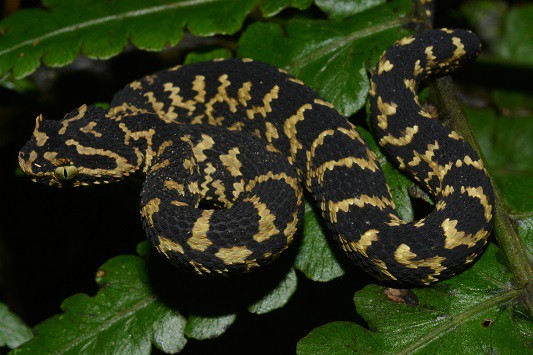
Part of the Atheris family containing the infamous hairy bush viper, this version lives exclusively in Tanzania, and exclusively within the Usambara mountain range. They rarely appear below 1400 metres, and have distinctive enlarged scales above each eye which resemble eyelashes.
Usambara eyelash vipers (Atheris ceratophora) are normally found on branches 1 metre above ground, but also on the forest floor amid leaf litter, near small forest streams. Sometimes they rest proudly on tree stumps 1 metre above ground. This is a short venomous snake, with a record length of 51cm found in Mazumbai Forest Reserve. But their yellow-black colours make them difficult to overlook.
Usambara eyelash vipers are confirmed to prey on African reed frogs (Hyperolius) in the wild, and in captivity, they happily eat frogs and geckos. Its closest relative is Matilda’s horned viper, from which it is estimated to have diverged 2.5 million years ago. There’s also subtle difference within the species, between those in the West and East Usambara mountains. These colonies are believed to have diverged 0.9 million years ago. Originally, this species was considered endemic to the east Usambara mountains alone, until individuals were found in the west Usambara in 1982.
| 3 | East African garter snake |
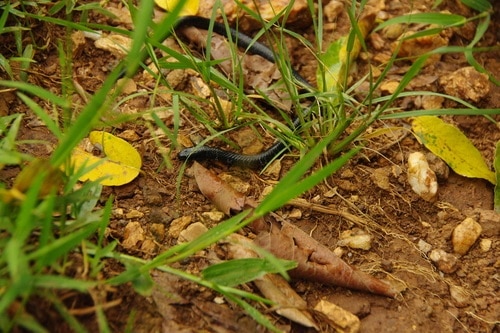
A shy snake with burrowing tendencies, which prefers to avoid human contact. This is not a member of the US garter snake family (Thamnophis), instead belonging to Elapsoidea, with 10 members, all found in sub-Saharan Africa. The East African garter snake reaches a maximum of 65cm and moves sluggishly through the African landscape, rather than quickly and alertly.
This is a black or dark grey snake. There’s variation in patterns, as some are monolithic, while others are decorated with gold bands, but the darkness always remains. Elapsoidea loveridgei feeds on various reptiles like geckos and skinks, and have a moderately sized empire, spanning Kenya, Tanzania, Rwanda and Uganda. They became an official species in 1971, when they were split from Sundevall’s garter snake.
Elapsoidea loveridgei is venomous, but cannot exceed local pain and moderate swelling in humans. Some report their venom to be neurotoxic, yet they’re so non-aggressive towards humans that there’s little risk. Their habitats are varied, including woodlands, savannah and grassland, but it’s more about the ability to burrow with this snake. They rarely climb trees, and it’s more likely that they lurk below your feet, just a few inches down, but safely secure from your Earth-quaking footsteps, out of sight from even the most sophisticated detecting machinery. It’s rare for this snake to appear below 800 metres in altitude, and the upper limit is 2400 metres. Like many burrowing snakes, they’re more likely to emerge after heavy rains.
| 4 | Red-snouted wolf snake |
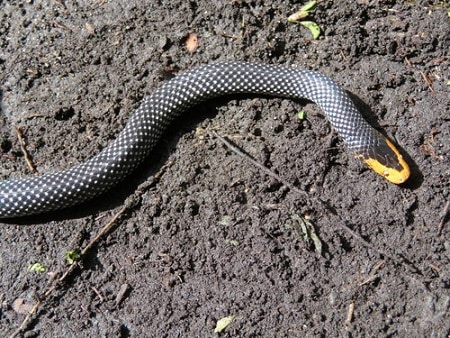
Another creature endemic to not just Tanzania, but the fantastical Usambara mountain range, a wonderland of rare creatures. The Lycphidion wolf snake family has 10 members, and while we know about the family overall, research for this rare Usambara species is almost non-existent.
Photos show a metallic grey snake with subtle white spots, and a bright yellow head which even spreads to its bright yellow eyes. They’re extremely easy to recognise because of this contrast. Lycophidion members have large, recurved teeth which are believed to aid in extracting lizard prey from their hidey-holes. Once captured, they constrict these lizards to death. Lycophidion members lay eggs, usually between 3 and 10.
Like the rest, red-snouted wolf snakes prefer damp locations, which are plentiful in their Usambara forests. Deforestation is rife in the Usambara mountains, as its residents are some of the poorest within Tanzania, reliant on subsistence agriculture. 70% of original forest cover has been lost in the eastern Usambara, while 10% of West Usambara forests were cleared from 1970 to 2000. Fortunately, the mountains were so cloaked in forest initially that vast swathes remain. Red-snouted wolf snakes average at 30cm and are believed to be nocturnal.
| 5 | Usambara forest snake |
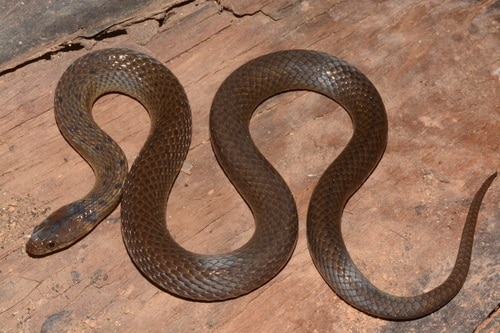
A Tanzanian snake you probably won’t ever meet. An Usumbara eyelash viper might hiss at you from a branch, not bothering to disguise itself, but Usumbara forest snakes (Buhoma vauerocegae) are shier and prefer to blend with the forest.
This species is varying shades of brown, from dark to light. They have round pupils, and are thought to be diurnal (day-faring). Thick forests are their home, where they lurk under a variety of objects. Usambara forest snakes have been found under fallen logs, thick overhanging branches, and loose bark, as well as on the forest floor. So far, prey discovered include two frogs. Buhoma vauerocegae is found only in the east Usambara mountains and the Ulguru mountains, both contained within Tanzania. It’s possible that they inhabit the west Usambara mountains as well, given how easily they vanish within their rainforests.
This is a short snake, as the longest Buhoma family member ever reached just 52cm. When picked up, Usambara forest snakes release an intolerable snake smell to deter predators, and supposedly, the smell is identical to the European grass snake’s (Natrix natrix) foul stench.
| 6 | Uluguru centipede-eater |
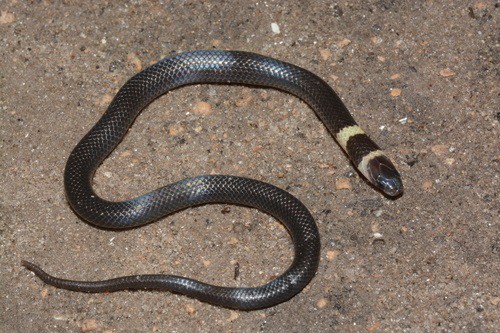
One of 11 Aparallactus centipede-eating snakes found in sub-Saharan Africa. This version inhabits eastern Zimbabwe, northern Mozambique, and finally Tanzania, where it seems to be most abundant.
Uluguru centipede-eaters (Aparallactus guentheri) have a mild venom, which simply bounces off humans ineffectually. They’re decent burrowers and are constantly rummaging around in loose soil, stones and under rocks for their centipede prey. They’re also known to eat scorpions. This species measures 30-45cm, and is completely dependent on forest, specifically lowland or submontane forest. You won’t find Ulguru centipede-eaters roaming dry plains or grassland.
Aparallactus guentheri is recognisable by its double white collar: a black head, followed by a white scarf, another small black patch, then a final white ring. This is followed by a sea of dark brown. In some individuals, the white bands are dark yellow instead. By contrast, the giant centipede eater (A. modestus) is a plain black with no collar, while the black-headed centipede eater (A. capensis) of Zimbabwe had a red body.
| 7 | Usambara vine snake |
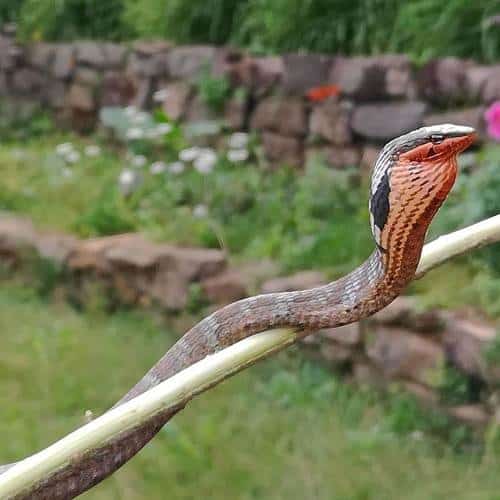
This tree-dwelling snake mostly inhabits coastal forests and mountains of northeast Tanzania, but also spills into the mountains of southern Kenya. Usambara vine snakes measure 90-130cm, maximum 140cm, and rarely leave their tree branches, travelling through forests or backgardens by leaping between them. They have a thin body, and a very long tail at 37-40% of body length, and can range from 0-2000 metres above sea level.
This is the second dangerously venomous snake on our list, but no detailed bite case studies exist. The reason we suspect danger is its close relative the bird snake (Thelotornis kirtlandii), which lives further west, and once caused a death in an 80 year old woman. Likewise, the eastern vine snake (T. mossambicus) of Mozambique can cause uncontrollable haemorrhaging.
Usambara vine snakes are confirmed to prey on fellow Tanzanian snakes such as the spotted bush snake. Somehow, there’s a remnant outpost of this snake on Vamizi Island, a small island off the northern Mozambique coast. This was discovered in 2012, and is separated from the main Tanzanian range by hundreds of miles.
| 8 | East African shovel snout |

A small Tanzanian snake which peaks at just 35cm. This species lacks any venom and also inhabits Mozambique and eastern South Africa. This snake may have a weird diet; it’s reported to feed on flying ants. One lucky photographer may see a mesmerizing scene of an East African shovel-snout lunging repeatedly upwards, trying to bite them out of mid-air. Confirmed prey include gecko eggs and juvenile lizards.
Prosymna stuhlmanni belongs to the Prosynma family of shovel snouts, with 18 members. These are usually fossorial, AKA underground-dwellers, but Prosymna stuhlmanni is less fossorial than the rest. They sometimes climb 1 metre high into trees, and invade fissures in the bark in order to swallow reptile eggs. They swallow the eggs whole, and prefer freshly laid eggs to old ones where embryos are more fully developed.
East African shovel snouts remain calm when confronted. Other shovel snout members coil and uncoil in order to intimidate, but Prosynma stuhlmanii stays still. This species has a grey back overlaid with tiny white dots, contrasting against a plain yellow belly.
| 9 | Common lined worm snake |
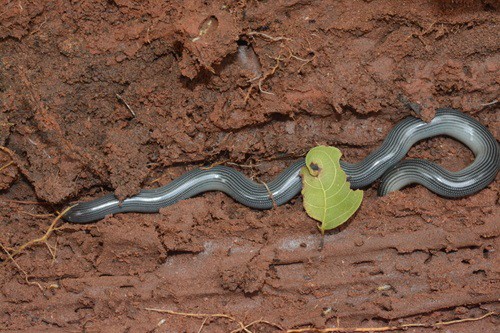
One Africa’s many blind snakes. This species is relatively large for a blind snake, reaching a maximum of 64cm, and with a thicker body. They’re most common in northern Tanzania and southern Kenya, and have the appearance of being lined, but really have multiple tiny white dots that fuse together from a distance, meaning that its name is false.
Common lined worm snakes (Afrotyphlops lineolatus) are found from sea level to 2600 metres, and can tolerate various habitats, including savannah, woodland and grassland. They only avoid the driest areas where burrowing becomes more difficult. For example, they’re rarely sighted in the drier central areas of Tanzania.
Common lined snakes eat termites, and even hide in nests of safari ants (Dorylus molestus). One was observed following the trail of a safari ant colony on their way to construct a new nest. Like most blind snakes, the best time to spot Afrotyphlops lineolatus is post heavy rains, when the increased moisture attracts them to the surface.
This Tanzanian snake has very few defensive abilities. They rarely bite, and injecting venom is out of the question (because they don’t have any). If harassed, Afrotyphlops lineolatus will vomit up its last meal, release a foul snake smell that forces people to flee, and poke enemies with its spiny tail, which is only slightly painful.
| 10 | Werner’s water snake |
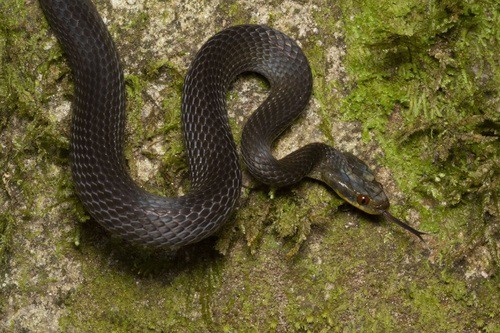
A relative of the red-lipped snake which often appears in suburban South African gardens. Werner’s water snakes (Crotaphopeltis tornieri) inhabit a swathe of Tanzania, northeast Zambia and extreme southern Kenya. This snake has bulging red eyes (with vertical pupils), but most of their body is a plain dark grey.
Werner’s water snakes measure 30-50cm and inhabit moist forests and their edges. They lurk under cover objects like logs, rotting leaves and forest debris whenever possible. They even invade insect tunnels, and seem to lay eggs communally. Individuals lay 10-12 eggs, but a clump of 78 Werner’s watersnake eggs was once found together, with 3 females nearby.
This is the opposite of the Usambara vine snake; instead of 37-40% of its body, is tail is stumpy and short, at 10% of its body. That’s because this snake mainly sticks to the ground (long tails are commonly for support on branches). The largest female Crotaphopeltis tornieri measured 58cm, and the largest male 63cm. Hatchlings are a mere 13cm. While apparently dull, this snake gains an iridescent sheen immediately after shedding its skin.
